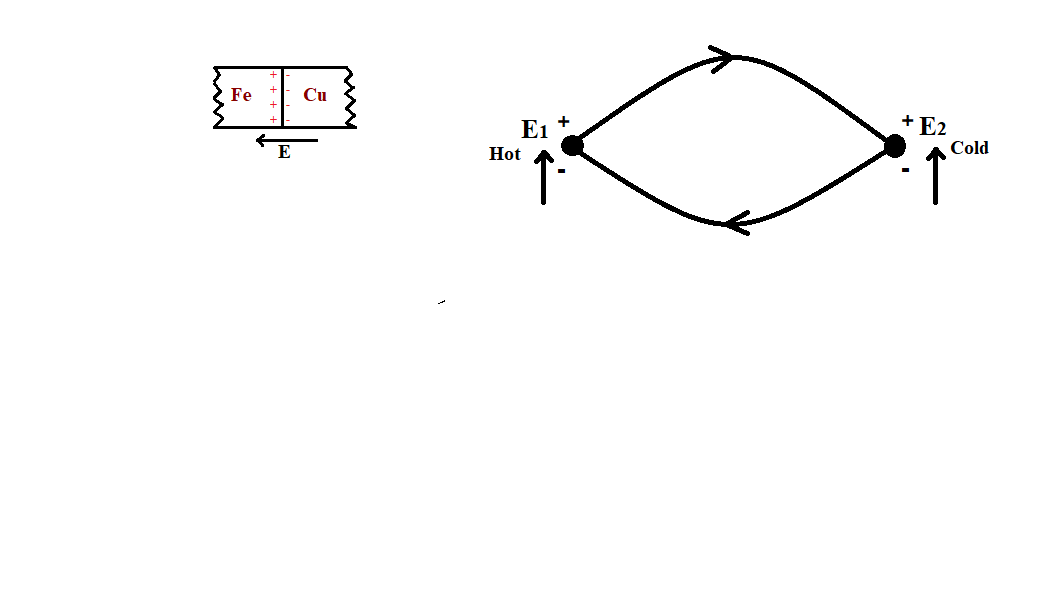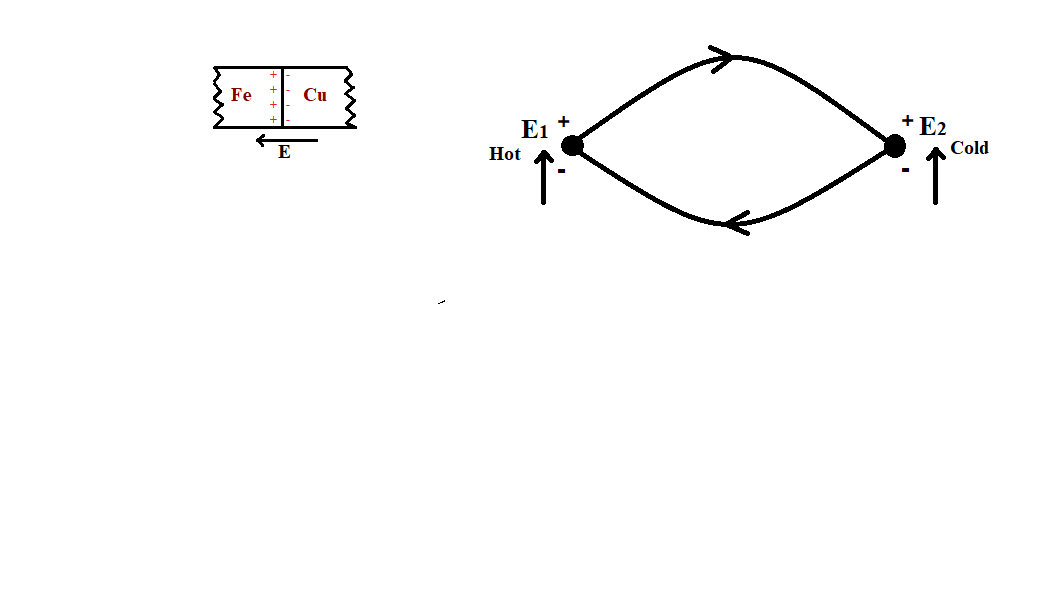
Answer
465.3k+ views
Hint: When two metals are placed at different temperatures, the temperature of the junctions remains different and it results in the development of an electric field across the two junction circuits. In case of a thermocouple made from similar materials, voltage across both wires or junctions would be the same. Differentiating it with respect to temperature would give a zero value.
Formula used:
For thermocouple made of similar metal, $\dfrac{dE}{dQ}=0$
Complete step-by-step solution -
Thermo emf is an electromotive force which is generated due to thermal gradient. The emf set up in a thermocouple, when its two junctions are kept at different temperatures is called a thermo emf. It is developed while keeping one junction at${{0}^{\circ }}C$. Value of thermo emf depends upon the nature of metals and temperature of junctions.
When two dissimilar metals are in contact, some free electrons diffuse from one metal (having lower work function) to the other metal (having higher work function). Thus one metal becomes positively charged and the other becomes negatively charged. This process continues until the difference developed is known as contact emf.
The direction and magnitude of contact emf depend upon what metals are used and the temperature of the junction. When copper is brought in contact with iron, more free electrons diffuse from iron to copper, thus making iron positive with respect to copper as.

When the junction of the metals forming the thermocouple are at the same temperature .the two contact electromotive forces, ${{E}_{1}}$and ${{E}_{2}}$, are equal in magnitude and of opposite polarity. However, if the two junctions of the thermocouple are at different temperatures, the contact emf at the hot junction is more than at the cold junction.

When a thermocouple made from two similar metals is heated to create a temperature gradient, the voltage across each wire would be the same. These voltages cancel out each other and result would be zero voltage across the two wires at all temperatures.
We are given,
$E=20Q-\dfrac{{{Q}^{2}}}{20}$
Differentiating with respect to$Q$
$\dfrac{dE}{dQ}=\dfrac{d\left( 20Q-\dfrac{{{Q}^{2}}}{20} \right)}{dQ}$
For thermocouple made of similar metal, we have,
$\dfrac{dE}{dQ}=0$
\[\begin{align}
& \dfrac{d\left( 20Q-\dfrac{{{Q}^{2}}}{20} \right)}{dQ}=0 \\
& 20-\dfrac{2Q}{20}=0 \\
& 400-2Q=0 \\
& Q=\dfrac{400}{2}=200 \\
\end{align}\]
$Q={{200}^{\circ }}C$
The neutral temperature of the thermocouple is ${{200}^{\circ }}C$
Hence, the correct option is D.
Note:When two metals are kept at different temperatures, it generates different junction temperatures for two metals. Thus, there is a net emf in the thermocouple and thermoelectric current flow in a particular direction. It may be noted that contact emf depends only on the work function of the metals, not on the size of metal or area of contact between metals.
Formula used:
For thermocouple made of similar metal, $\dfrac{dE}{dQ}=0$
Complete step-by-step solution -
Thermo emf is an electromotive force which is generated due to thermal gradient. The emf set up in a thermocouple, when its two junctions are kept at different temperatures is called a thermo emf. It is developed while keeping one junction at${{0}^{\circ }}C$. Value of thermo emf depends upon the nature of metals and temperature of junctions.
When two dissimilar metals are in contact, some free electrons diffuse from one metal (having lower work function) to the other metal (having higher work function). Thus one metal becomes positively charged and the other becomes negatively charged. This process continues until the difference developed is known as contact emf.
The direction and magnitude of contact emf depend upon what metals are used and the temperature of the junction. When copper is brought in contact with iron, more free electrons diffuse from iron to copper, thus making iron positive with respect to copper as.

When the junction of the metals forming the thermocouple are at the same temperature .the two contact electromotive forces, ${{E}_{1}}$and ${{E}_{2}}$, are equal in magnitude and of opposite polarity. However, if the two junctions of the thermocouple are at different temperatures, the contact emf at the hot junction is more than at the cold junction.

When a thermocouple made from two similar metals is heated to create a temperature gradient, the voltage across each wire would be the same. These voltages cancel out each other and result would be zero voltage across the two wires at all temperatures.
We are given,
$E=20Q-\dfrac{{{Q}^{2}}}{20}$
Differentiating with respect to$Q$
$\dfrac{dE}{dQ}=\dfrac{d\left( 20Q-\dfrac{{{Q}^{2}}}{20} \right)}{dQ}$
For thermocouple made of similar metal, we have,
$\dfrac{dE}{dQ}=0$
\[\begin{align}
& \dfrac{d\left( 20Q-\dfrac{{{Q}^{2}}}{20} \right)}{dQ}=0 \\
& 20-\dfrac{2Q}{20}=0 \\
& 400-2Q=0 \\
& Q=\dfrac{400}{2}=200 \\
\end{align}\]
$Q={{200}^{\circ }}C$
The neutral temperature of the thermocouple is ${{200}^{\circ }}C$
Hence, the correct option is D.
Note:When two metals are kept at different temperatures, it generates different junction temperatures for two metals. Thus, there is a net emf in the thermocouple and thermoelectric current flow in a particular direction. It may be noted that contact emf depends only on the work function of the metals, not on the size of metal or area of contact between metals.
Recently Updated Pages
Who among the following was the religious guru of class 7 social science CBSE

what is the correct chronological order of the following class 10 social science CBSE

Which of the following was not the actual cause for class 10 social science CBSE

Which of the following statements is not correct A class 10 social science CBSE

Which of the following leaders was not present in the class 10 social science CBSE

Garampani Sanctuary is located at A Diphu Assam B Gangtok class 10 social science CBSE

Trending doubts
A rainbow has circular shape because A The earth is class 11 physics CBSE

Which are the Top 10 Largest Countries of the World?

Fill the blanks with the suitable prepositions 1 The class 9 english CBSE

Which of the following was the capital of the Surasena class 6 social science CBSE

How do you graph the function fx 4x class 9 maths CBSE

The Equation xxx + 2 is Satisfied when x is Equal to Class 10 Maths

Give 10 examples for herbs , shrubs , climbers , creepers

Difference between Prokaryotic cell and Eukaryotic class 11 biology CBSE

Who was the first Director General of the Archaeological class 10 social science CBSE




